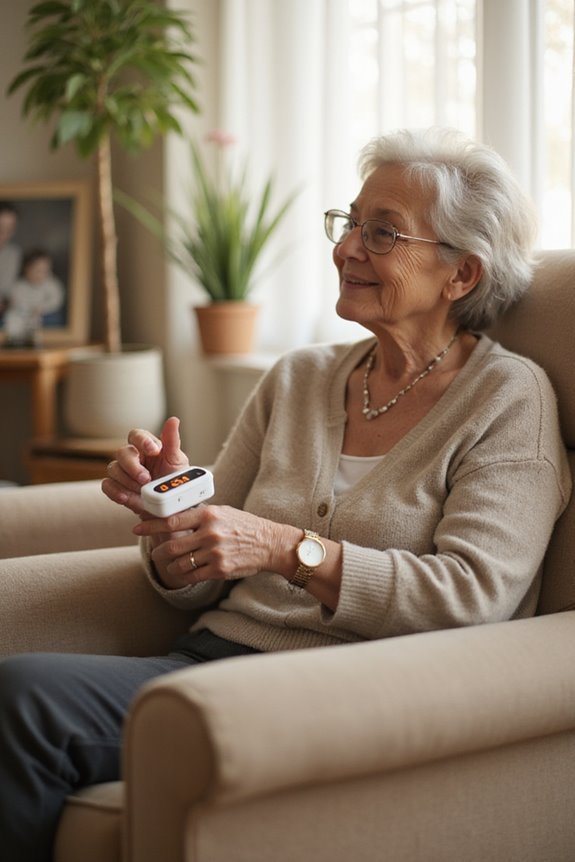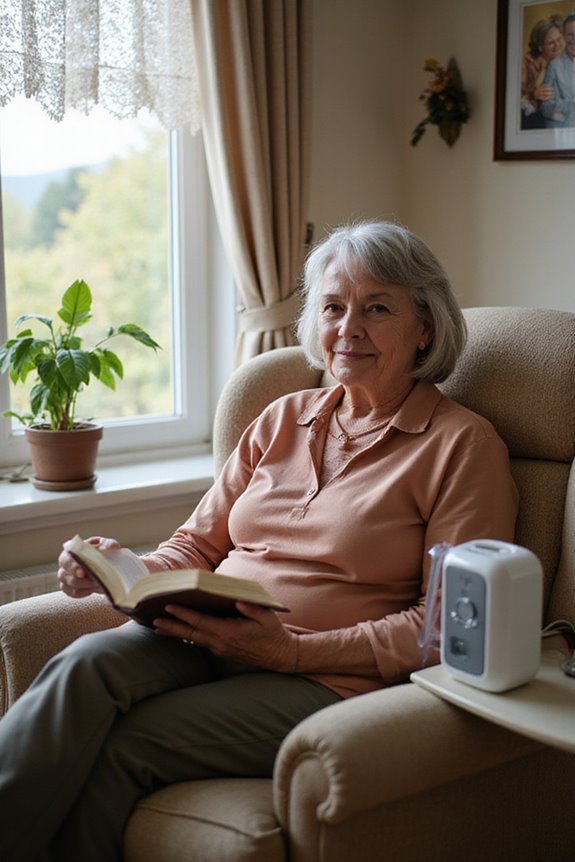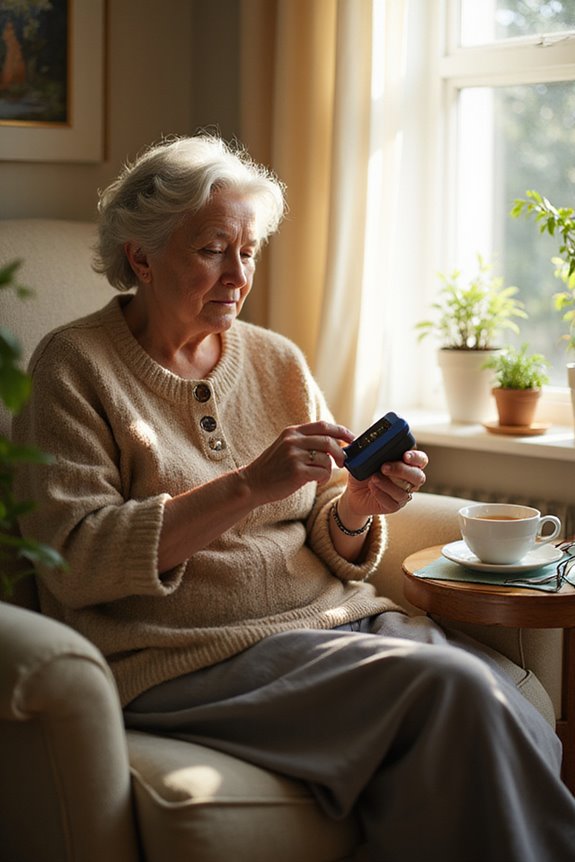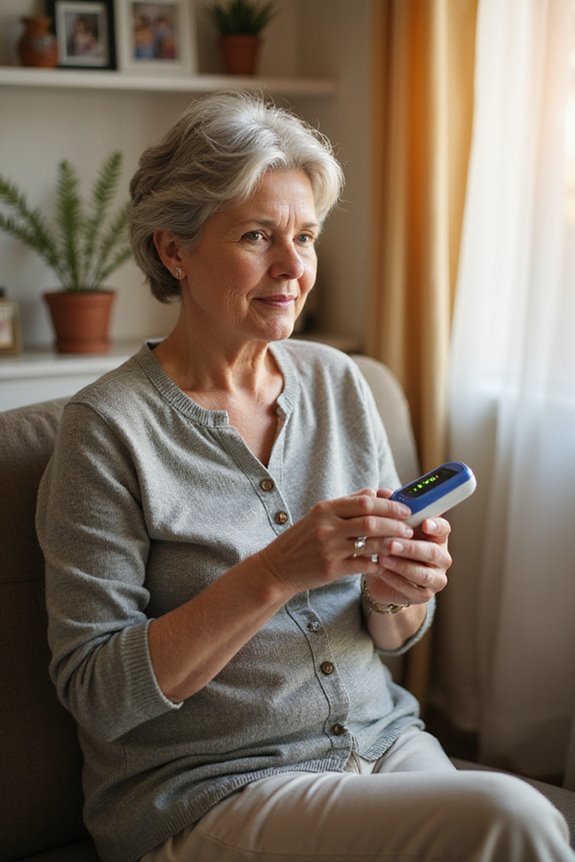To use a fingertip pulse oximeter, first prepare the environment by guaranteeing dim lighting and a comfortable temperature. Place the device on a clean, dry middle or index finger, aligned with the red light over the nail. Activate the device and remain still for at least one minute for stable readings. Normal oxygen saturation is between 94%-99%. Values below 93% require medical consultation. Following these guidelines guarantees accurate measurements and effective usage. Further insights are available for deeper understanding.
Key Takeaways
- Ensure the environment is dimly lit, comfortable, and free from distractions before using the pulse oximeter.
- Place the probe securely on a clean middle or index finger, aligning the red light over the nail.
- Activate the device and keep the hand still for at least one minute to allow readings to stabilize.
- Monitor oxygen saturation levels, noting that normal readings range from 94% to 99%.
- Clean the device after each use with isopropyl alcohol and store it in a dry environment.
Preparing to Use the Device
Preparing to use a fingertip pulse oximeter involves several critical steps to guarantee accurate readings and peak performance.
Environment Setup
- Confirm the room is free from bright ambient light.
- Maintain a comfortable temperature to keep hands warm.
- Minimize distractions during the measurement process.
- Keep the area clean and obstacle-free.
- Confirm power sources are available if required by the device.
Patient Readiness
- The patient should rest for at least five minutes before measurement.
- Encourage the patient to remain still and calm.
- Warm cold hands by rubbing together gently.
- Remove jewelry or clothing that may obstruct the oximeter.
- Position the patient’s arm at waist level for best readings.
Proper Placement and Activation
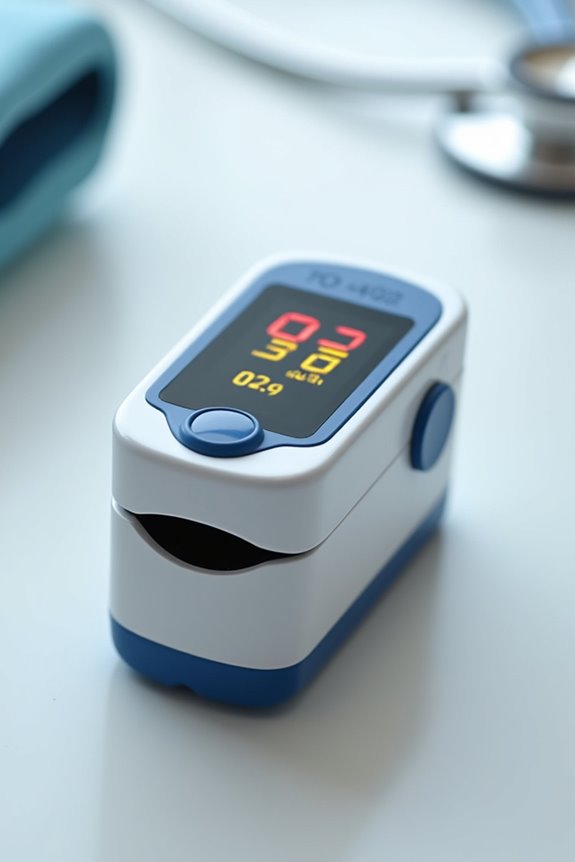
Proper placement and activation of a fingertip pulse oximeter are essential for obtaining accurate measurements. For ideal finger placement, position the probe on a clean, dry middle or index finger, ensuring the red light portion aligns directly over the fingernail. Avoid fingers with nail polish, artificial nails, or bandages, and do not use excessively cold or damp fingers.
Probe positioning requires a snug fit without restricting circulation. If necessary, secure with fabric tape. The cable must connect securely to the oximeter, routed along the hand’s top to prevent interference. Before activation, check connections for integrity, ensuring the device is powered and initialized. According to accuracy and reliability, monitor for stable readings, as the device may take several seconds to stabilize.
Taking the Measurement
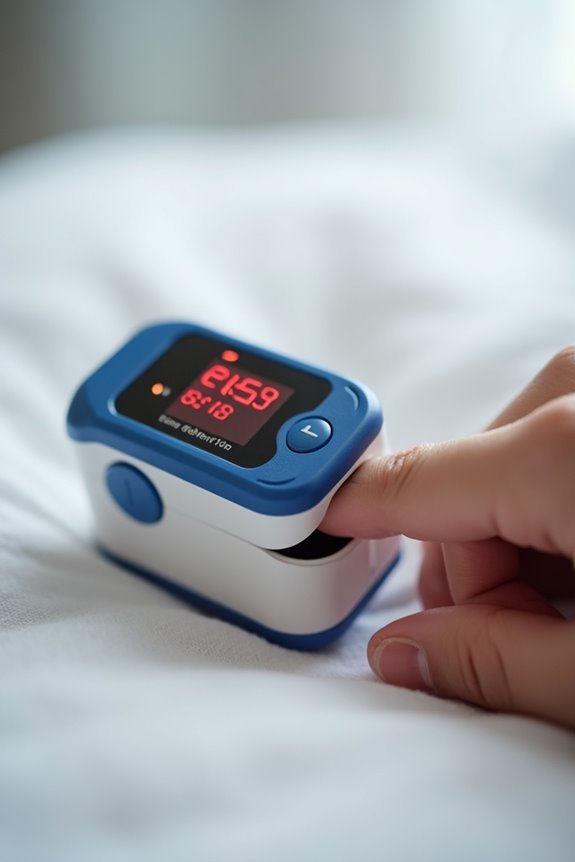
Taking the measurement with a fingertip pulse oximeter involves several critical steps to guarantee accuracy and reliability.
Preparation
- Confirm the individual rests for at least five minutes.
- Remove any nail polish or artificial nails.
- Warm the hand if necessary and maintain it at heart level.
Measurement Timing
- Apply the pulse oximeter to the middle or index finger, confirming proper alignment.
- Activate the device and keep the hand still.
Stabilization
- Allow one minute for the reading to stabilize, monitoring for fluctuations.
- Record the steady oxygen saturation value over five seconds, along with the heart rate.
Recording Accuracy
– Log measurements in a smartphone app or diary for effective tracking and future consultations. Additionally, ensure that the monitor has been calibrated against medical-grade monitors to enhance trust in its performance.
Interpreting the Results
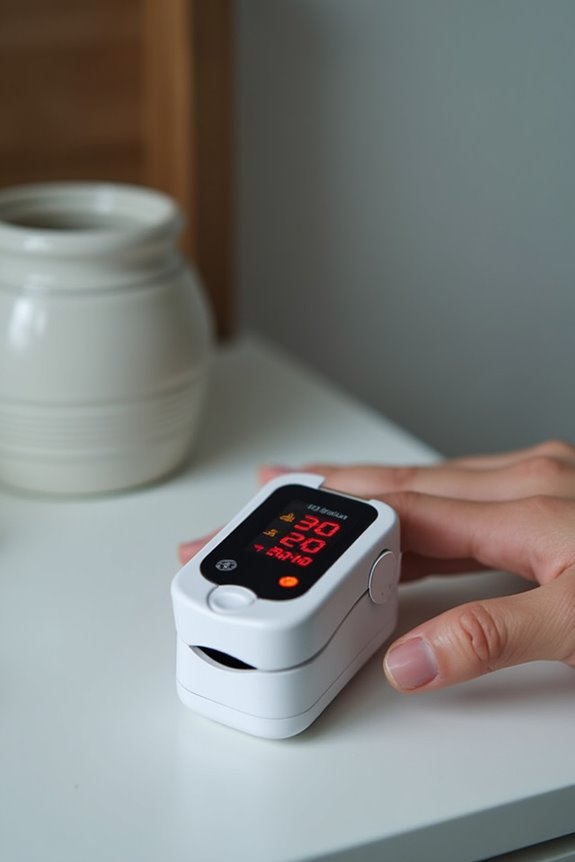
Normal Readings
A healthy oxygen saturation level typically ranges from 94% to 99%. Readings within this range indicate adequate oxygen levels.
Low Readings
Oxygen saturation levels between 93% and 94% necessitate contacting a healthcare provider for guidance. Levels at or below 92% require immediate medical attention.
It is crucial to take into account heart rate alongside oxygen saturation. A resting heart rate of 50 to 90 bpm is normal. Elevated rates combined with low oxygen levels may indicate underlying health issues. Additionally, factors such as improper positioning can affect the accuracy of readings, so ensure hands are warm and still, and avoid artificial nails or polish. Recognizing these factors aids in making informed health decisions based on pulse oximeter data.
Device Usage Best Practices
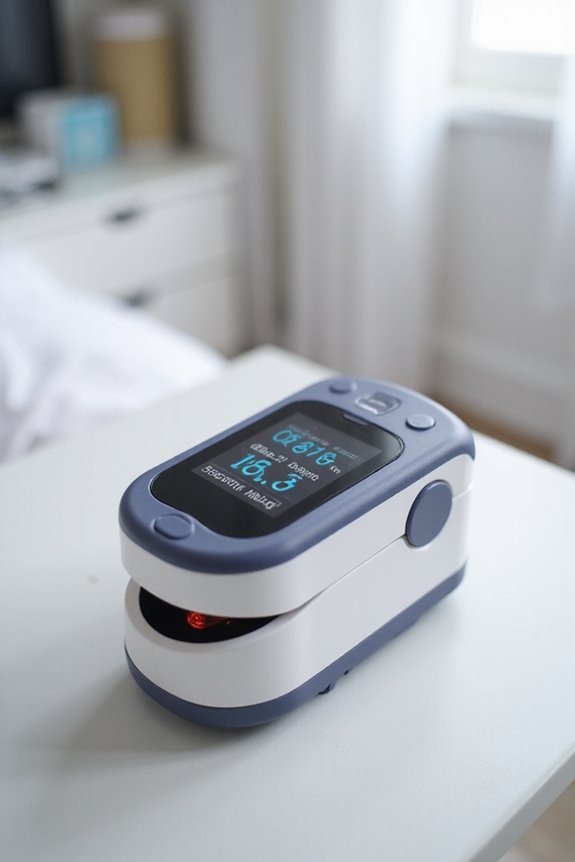
Effective usage of a fingertip pulse oximeter requires adherence to established best practices to guarantee accurate readings. Key practices include:
- Preparation: Remove nail polish, warm hands, and rest for five minutes prior to measurement.
- Device Placement: Use the middle or index finger, attach the device securely, and keep the hand at heart level.
- Stability: Remain still during the reading, allowing the pulse oximeter features to stabilize for at least one minute.
For ideal user experience, it is essential to identify and record the highest stable readings, noting that accuracy is best between 90% and 100% oxygen saturation levels. Consistent monitoring, ideally three times daily, helps track health changes effectively. Additionally, ensure that the device provides measurement accuracy within a +/- 1% range for reliable results.
Maintenance and Care
Proper maintenance and care of a fingertip pulse oximeter are essential for ensuring its accurate performance and longevity.
Battery Maintenance
- Replace batteries promptly when low voltage indicators appear.
- Remove batteries during extended storage to prevent leakage.
- Dispose of used batteries according to local regulations.
Cleaning Procedures
- Power off the device before cleaning.
- Use a soft cloth with 70-75% isopropyl alcohol for surfaces.
- Clean fingers before and after measurements.
Storage Conditions
- Store in a dry environment with humidity below 93%.
- Maintain temperature within -20°C to +55°C.
Device Inspection
– Regularly inspect for wear, ensuring smooth operation and readability.
Disinfection Protocols
– Disinfect surfaces after each use with approved agents to prevent cross-contamination.
Understanding Technical Limitations
Understanding the technical limitations of fingertip pulse oximeters is essential for accurate interpretation of their readings. Various factors can affect measurement accuracy, including:
- Poor Circulation: Inadequate blood flow may yield erroneous results.
- Skin Pigmentation: Darker skin can lead to device biases, making readings less reliable.
- Nail Polish: Certain types can obstruct light transmission.
- Cold Extremities: Low skin temperature often interferes with accuracy.
- Motion Artifact: Physical movement disrupts readings.
Moreover, studies highlight that inaccuracies can be around 2% compared to arterial blood gas tests. This can lead to occult hypoxemia, delaying proper treatment. Awareness of these limitations is critical for users to guarantee effective monitoring and timely healthcare responses. Additionally, it is recommended to ensure calibration frequency every 6 months to maintain accuracy and reliability in readings.
Frequently Asked Questions
Can I Use the Pulse Oximeter on Children?
Using a pulse oximeter on children is possible, but requires pediatric-specific devices for ideal reading accuracy. Ensuring child safety involves selecting appropriate sensors, minimizing movement, and considering skin conditions to achieve reliable results.
What Should I Do if the Reading Seems Inaccurate?
When readings appear inaccurate, individuals should consider troubleshooting tips like checking sensor placement and removing nail polish. Common mistakes, such as poor positioning or environmental interference, can greatly affect the reliability of measurements.
How Often Should I Check My Oxygen Saturation?
In matters of health, timing is everything. Monitoring oxygen levels should align with individual conditions: intermittently for moderate illness, continuously for severe cases, and occasionally for mild symptoms, ensuring a safe measurement frequency tailored to needs.
Can I Use It With a Tattoo on My Finger?
Using a pulse oximeter on a tattooed finger can produce unreliable readings due to tattoo effects, similar to skin pigmentation challenges. Caution is advised, and alternative sites should be considered for more accurate measurements.
Is It Safe to Use a Pulse Oximeter During Exercise?
Pulse oximeters can enhance exercise safety through real-time monitoring, yet their pulse accuracy may falter during intense activity. Balancing reliable insights with caution, users must heed symptoms and seek medical guidance as needed.

